By Pepper Parr
BURLINGTON, ON. And there it was. Burlington’s first piece of public art that was the result of a joint private benefactor, public funds sculpture sitting outside the two-year old Performing Arts Centre.
The art was the result of an idea Burlington businessman Dan Lawrie had that led to a conversation with former Centre Executive Director Brenda Heatherington, about a sculpture for the Centre. The idea worked its way to city council where they agreed to add to the generous financial contribution Lawrie had made.
That brought the city’s Public Art contractor Jeremy Freiburger into the picture. He was tasked to put together a jury to decide what should be installed. A jury was selected and a decision made. Throughout the process the public was involved and the result was a gathering of citizens on a bright sunny day, to unveil the 17 foot sculpture done for the city by New Brunswick based artist Peter Powning.
The jury, made up of Burlington Art Centre president Ian Ross, artist Trevor Copp, Emma Quin, Executive Director of the Ontario Craft Council narrowed the 119 entries down to three finalists and chose Peter Powning’s submission.
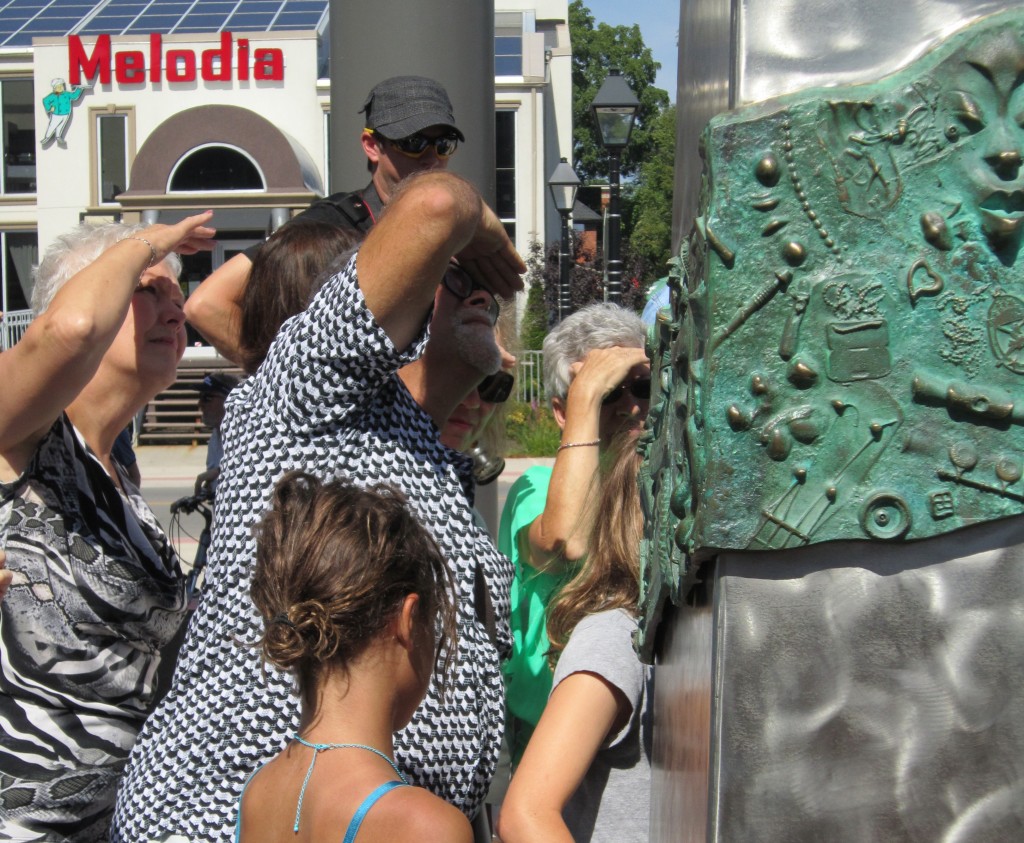
And now the Stela gets its first public close up. Do they like what they see? Will it grow on people? Was it a good idea?
The city wanted art that involved the public and that brought out the idea of a “cultural mulch”; a phrase that was as new to Burlington as it was to the artistic community. Cultural Mulch was described as “stories about who we are and where we grow.”
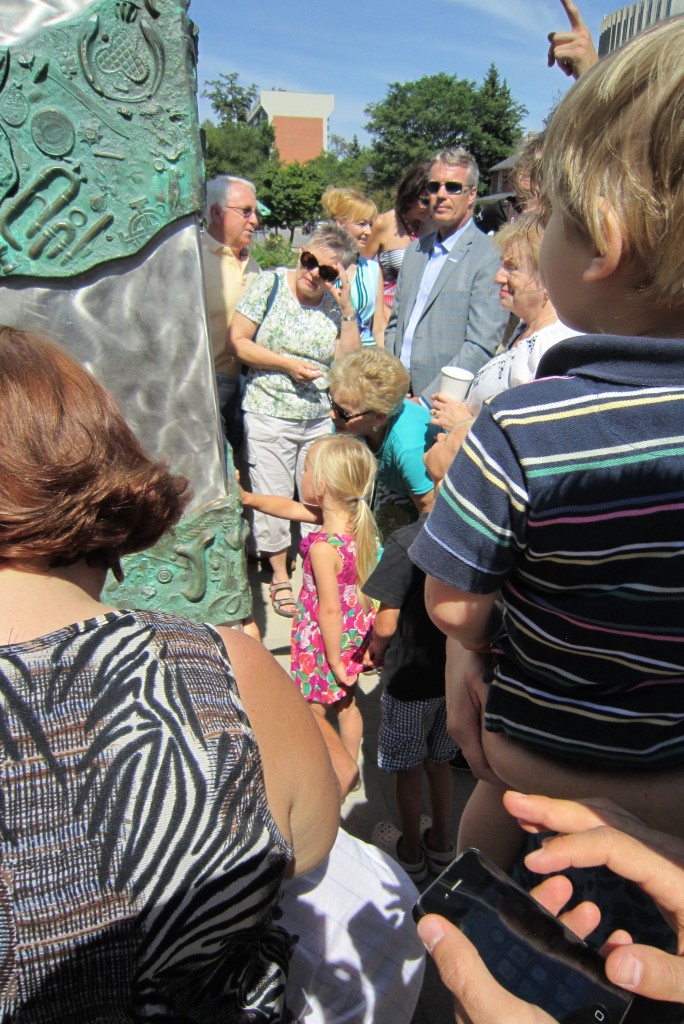
People gather around to see what has been placed into the sheets of bronze that are attached to the Stela. The word was spread quickly as people photographed and “tweeted” about what they were seeing.
That led to a number of sessions where Powning took plaster impressions of various artifacts the public brought in. Powning had no idea what the next person in line was going to give him. Some brought in old keys, other brought in a pair of binoculars that had belonged to their grandfather. Another person brought in a pocket watch fob while yet another brought in a ticket from the opening day of the Centre.
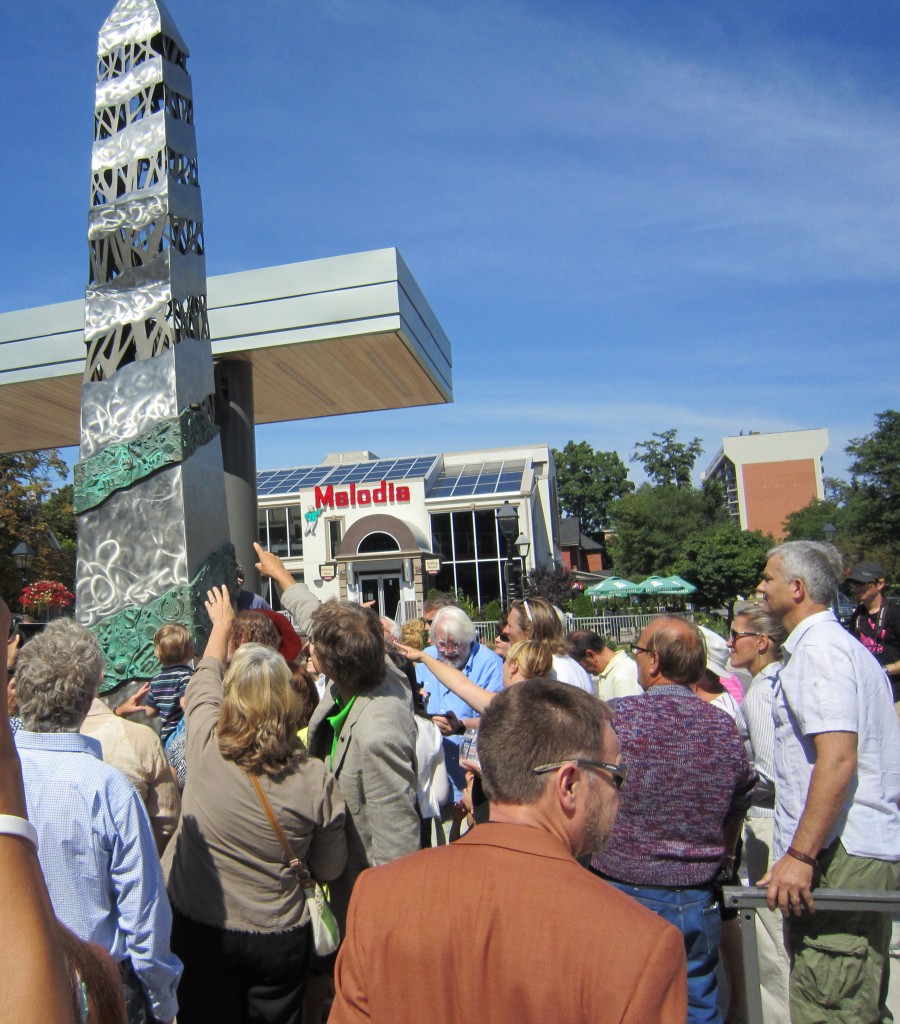
The Spiral Stela was certainly getting a lot of attention from the unveiling day crowd. What was that piece, and that piece there, where did that come from. The Stela needs a close look and some time to figure out what it’s all about.
There were medals and toy trucks – anything the people of Burlington thought described who they were. With the plaster impressions done Powning trucked it all back to his workshop in New Brunswick where bronze castings were made which were then attached to the stainless steel obelisk shaped structure.
The Spiral Stela is now, like the Pier, part of the city and in time the public will come to appreciate what they have outside the Centre. Jeremy Freiburger, who also wrote a Cultural Plan for the city, believes Burlington has begun a change to a more artistically sophisticated city.
Ward 2 Councillor described what had happened very well when she said “the role of public art reflects what a community is” and what is crafted into the sheets of bronze on the Spiral Stela certainly describes the city, rather proudly.
Public art was described by Dan Lawrie as a “manifestation of a community coming together” and is a lot more than a possession but rather “a collection of memories that will get passed from generation to generation. It is a perpetual memory and a permanent landmark.”
The beauty of a piece of art is usually in the eye of the beholder. When good art is made part of the public environment the understanding of what art can do and the impact art has on our daily lives goes through a transition. Some art is accepted immediately while other art is part of controversial conversations for a long time.
Peter Powning spoke later to a small audience at the Art Centre about public art and the impact it has had on his career. Powning earns his living working full-time on commissions which come from the corporate sector but is driven now to a considerable degree by the municipal sector.
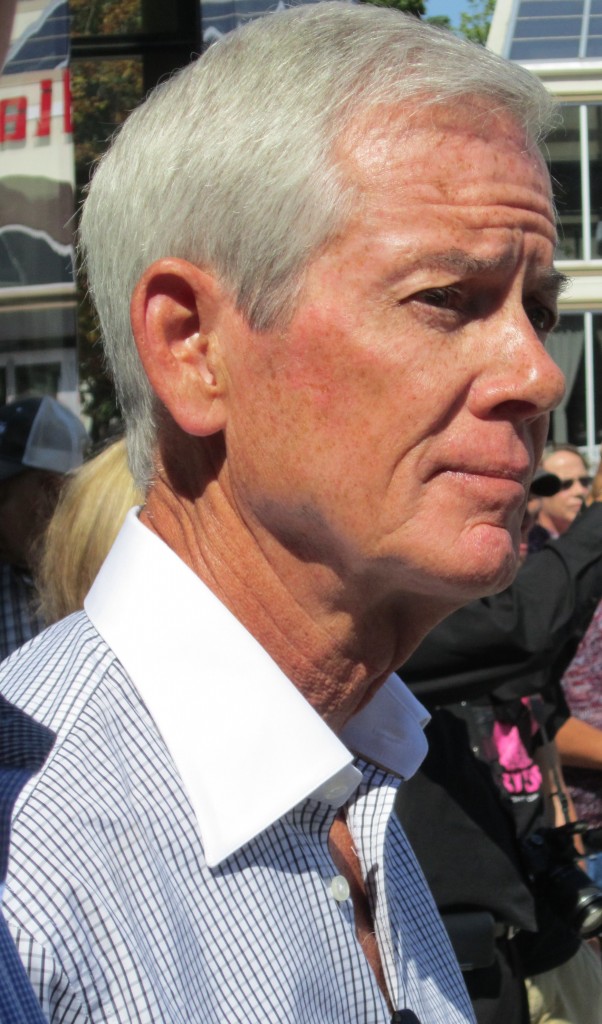
It was Dan Lawrie’s idea and his willingness to put up $37,000+ of his own money that started the process that ended with a piece of public art being unveiled outside the Performing Arts Centre.
In 1983 Powning was able to convince a developer to include funding for art in a project budget. One of his early projects was a piece of art in the Market Square in St. John, New Brunswick that Powning said is “still there and holding up very well”.
The value of public art explained Powning is that it gives a community an opportunity to say who they are – to say what a locality’s destiny is. It is a cultural eruption that has value that accrues to a community.
When Powning saw the notice Burlington published for public art submissions and he looked at the site he immediately saw some very interesting potential. When he learned that the city wanted significant intense community participation Powning knew this was a project he could develop and convinced the jury he was the man to do the job.
Powning was one of three finalists out of the 119 artists who responded to the call.

Rick Burgess, on the left with Mayor Goldring and sculpture benefactor Dan Lawrie look over the newly unveiled piece of public art.
Public art explained Powning can be “serene, bold or provocative”. If it results in controversy there is growth in the thinking of a community and as long as it is not too far outside commonly accepted boundaries acceptance takes place.
Powning feels public art helps a community gets away from the “big box” culture that is dominated by a profit or loss report. Buildings are put up for profit where the objective is to keep costs down. Spending thousands of dollars on something that does not have a profit attached to it is a hard sell not only to developers but to the general public as well. If you have been following the comments about spending public money on the Freeman Station you will get a sense of how the public debate plays itself out. Pay particular attention to the comments part of the story.
The evolution of art for the public has grown from bronze statues of Kings and Queens and major public figures, usually military types to the Rebecca outside the Art Centre that is still surrounded by controversy.
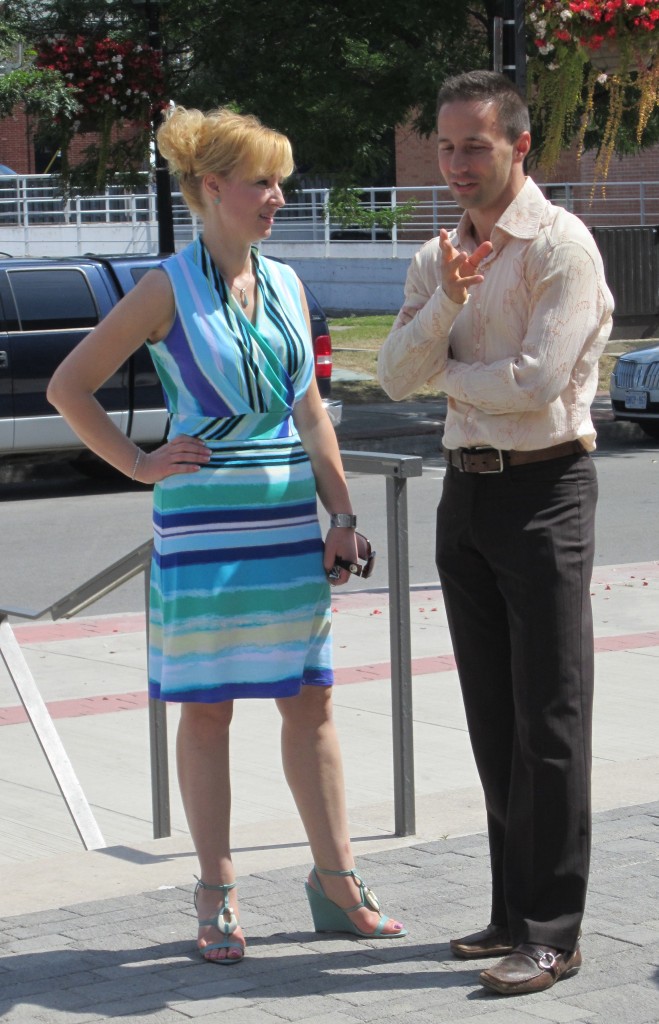
Cultural projects manager Angela Paparizo and Stela selection jury member talk about the next project for the city?
Powning points out that public art has moved away from themes and is not tied down to anything specific but is now much more interpretive.
Powning convinced the public art jury to go along with his Stela approach but had no idea what he would be given by the public to work with.
As individual artifacts were put in front of him he had to make the plaster impression but at the same time listen to the story people told and remember what he heard and what he felt as he listened.
All these words and feelings were taken back to New Brunswick where the creative process began. Where should the individual artifacts be placed? Is there a theme that comes out of what he was given? Is there a theme he wants to create? What are the space limitations he has to deal with?
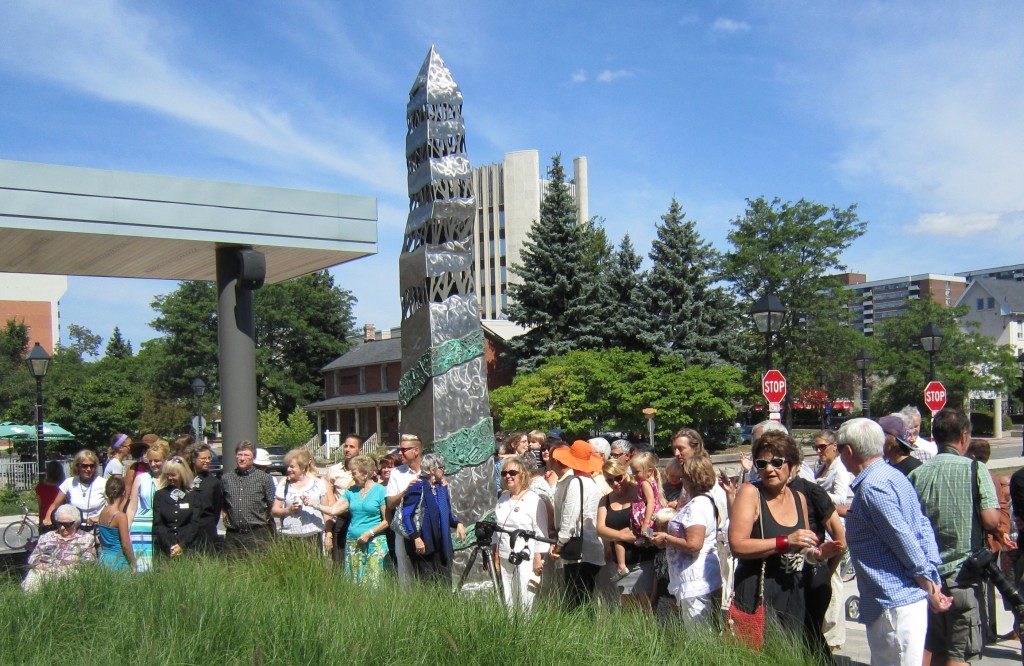
Were you there? You should have been. People milled about and asked questions and talked about this newest addition to the city’s cultural fabric.
“There are no rules for this kind of work – it is pure visual improvisation”, said Powning.. There are breakthroughs as you are doing the work. “You count on those” added Powning who has done a number of Stela’s across the country. One of the more outstanding Stela’s was done in Canmore, Alberta where there was a theme based on eagles that would fly between two mountains at the edge of the city. Eagles became the theme for that Stela and Powning built on it.
Burlington didn’t have a single theme. For once the Burlington bookends of the lake and the Escarpment didn’t take over the dialogue; instead Powning worked from material given to him by the community.
The result is a bronze structure that now stands outside the Centre that is expected to become the hub of a community’s cultural aspirations.
Powning and his wife, a writer, were married when Peter was 19. They had decided they were going to live “off the grid” long before that was an accepted phrase. They were part of the “back to the land” movement, and live in a place where the telephone line doesn’t always work the way most of us expect it to work. They have enough in the way of solar panels on their buildings to supply most of their energy and grow much of the food they need.
Powning will keep in touch with how Burlington reacts to and grows with its Stela. Public art does have to be maintained; you can’t put it up and just leave it there. Burlington’s Spiral Stela is covered with a coating of wax that makes it easier to clean and Powning will probably come back to Burlington to put a new coat of wax on the sculpture in a couple of years.
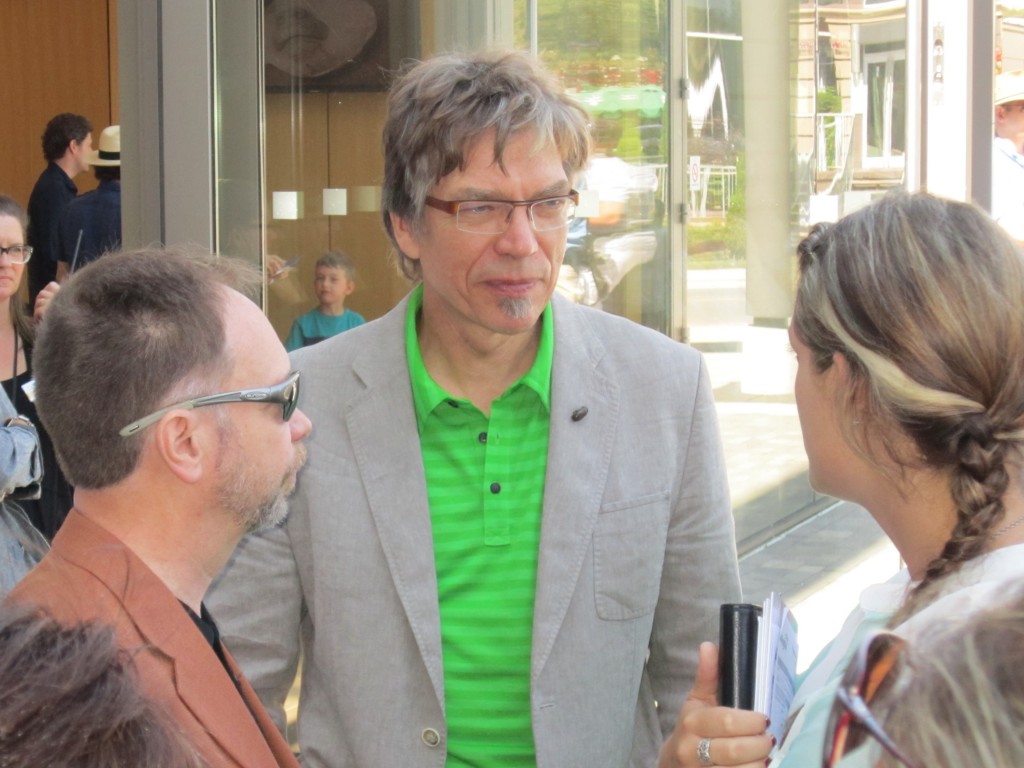
Performing Arts Centre board chair Rick Burgess on the left with artist Peter Powning centre, talking to a city staff member.
Before getting driven to the airport to return home, Powning asked for some time to get back to his sculpture and take a few pictures – he has been so busy getting it installed and talking about it that he hadn’t had any time to photograph the work.
The public will now begin walking over to the Stela just the way they now walk out onto the pier. In the not too distant future the city hopes to have a web site with many different views of the Stela where people can tag different parts of the bronze pieces.
The art does need some sort of a plaque or notice put in place that explains what the object on the bronze portions are all about – and that’s about the only criticism one can make about the unveiling of the Spiral Stela in front of the Performing Arts Centre on a sunny Sunday morning. We did good.














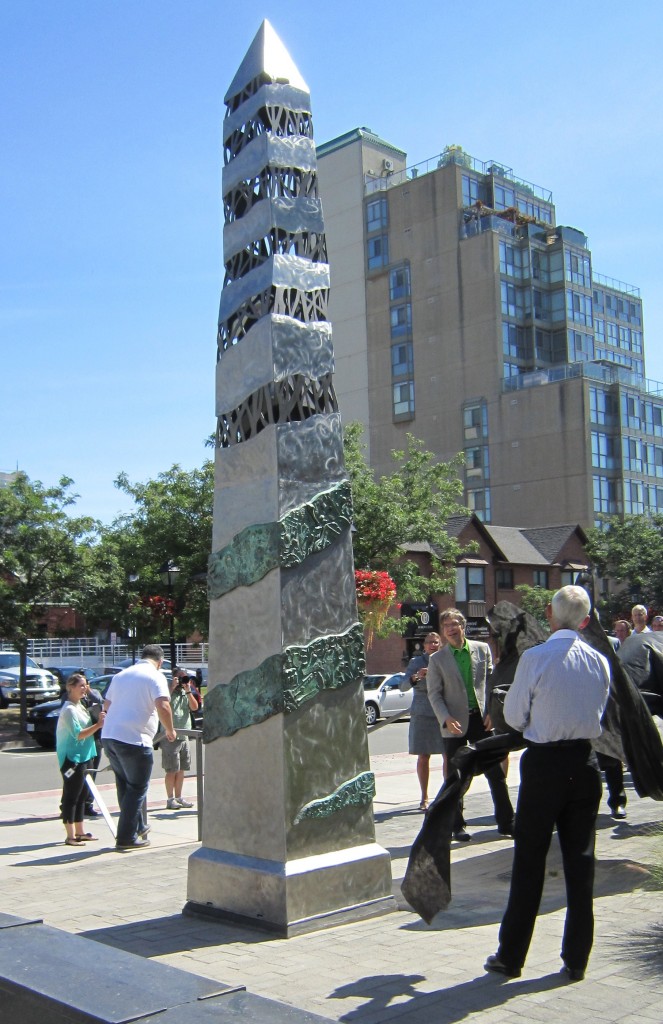






An obelisk rises from our children’s feet.
Separating, branching upwards.
Combining, culminating, mulching.
Together, moving forward.
This is Burlington.
A joy to meet you all.
That is art.
Thanks Peter Powning
Mark Twain was quoted when touring Paris art museums what he thought of the art. He was quoted ” I do not know much about art but I do know what I do not like and I do not like that”
I need to agree with Mark Twain however as beauty is in he eye of the beholder – maybe others will think is is pretty.
Minor point, but did something happen to this piece ‘on route’ to the site?
(… it looks like that pier crane fell on the top section… )
It sure doesn’t look like the ‘straight’ obelisk base shown in the winning ‘design’ maquette. See ‘design preview’ here: https://canadadaphotography.blogspot.ca/2012/09/help-wanted-public-art-in-burlington.html
Ah well. It’s ‘ours’ now. I’m sure Burlingtonians, old and new, will learn to love it.
There was a design change asked for by the jury that chose Powning. They wanted something with a little more character to it – and that crooked bit at the top is what they got.
Juries do have the right to ask for changes. It would have been nice if they had mentioned this somewhere along the way.
What the public wonders is – does Margaret Lindsay Holton have an artifact on the Spiral Stela? And if she does – where is it?
I hope so. I haven’t had a chance to check yet, so who knows … I understand that designs do ‘morph’ and ‘evolve’, but still, that top just looks, as you say, crooked.
We’ll all get used to it I’m sure, just as we have done the ‘Lady of the Lake’ fountain at the waterfront …
By the way, does the editor have any idea, what that recent restoration/upgrade of said fountain cost Burlington taxpayers?
Curious readers would like to know.
More here: https://cms.burlington.ca/Page9213.aspx